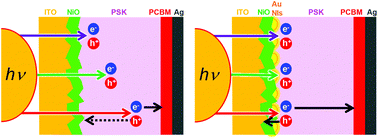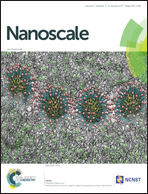Versatile plasmonic-effects at the interface of inverted perovskite solar cells†
Abstract
Plasmonics is a highly promising approach to enhancing the light-harvesting properties of hybrid organic/inorganic perovskite solar cells. In the present work, our cells have a p–i–n inverted planar structure. An ultrathin NiO film with two different thicknesses of 5 and 10 nm prepared by a pulsed laser deposition process on an ITO substrate with a faceted and furrowed surface enabled the formation of a continuous and compact layer of well-crystallized CH3NH3PbI3via an anti-solvent chlorobenzene process. The coverage mechanism of the NiO film on the ITO was clearly demonstrated through the J–V and external quantum efficiency (EQE) curves. Moreover, the results demonstrated that the gold nanoislands (Au NIs) increased the power conversion efficiency to 5.1%, almost double that of the samples without Au NIs. This result is due to the excitation of surface plasmons, which is characterized by strong scattering and enhancement of the electric field in the vicinity of the Au NIs loaded at the interface between the NiO and perovskite films. Additionally, we observed an enhancement of the EQE at wavelengths shorter than the plasmon resonance peak. In the current state, we speculate that the plasmoelectric potential effect is considered to be a good explanation of the photocurrent enhancement at the off-resonance region. Our work provides good guidance for the design and fabrication of solar-energy-related devices employing NiO electrodes and plasmonic Au NIs.

- This article is part of the themed collection: Editor’s Choice: Perovskite Nanomaterials and Devices

 Please wait while we load your content...
Please wait while we load your content...